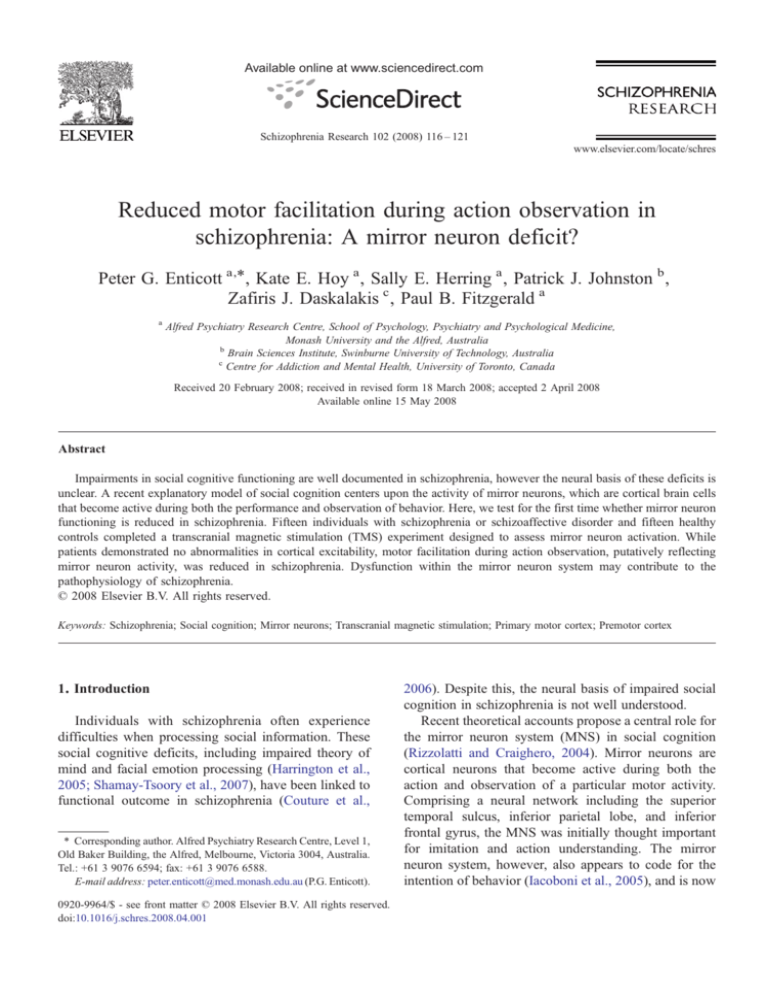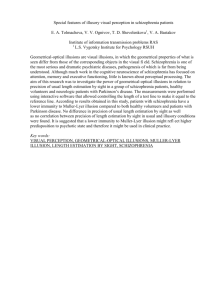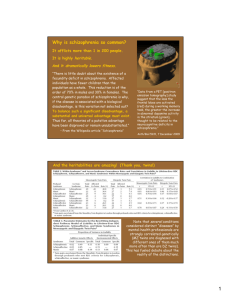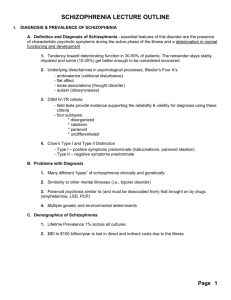
Available online at www.sciencedirect.com
Schizophrenia Research 102 (2008) 116 – 121
www.elsevier.com/locate/schres
Reduced motor facilitation during action observation in
schizophrenia: A mirror neuron deficit?
Peter G. Enticott a,⁎, Kate E. Hoy a , Sally E. Herring a , Patrick J. Johnston b ,
Zafiris J. Daskalakis c , Paul B. Fitzgerald a
a
Alfred Psychiatry Research Centre, School of Psychology, Psychiatry and Psychological Medicine,
Monash University and the Alfred, Australia
b
Brain Sciences Institute, Swinburne University of Technology, Australia
c
Centre for Addiction and Mental Health, University of Toronto, Canada
Received 20 February 2008; received in revised form 18 March 2008; accepted 2 April 2008
Available online 15 May 2008
Abstract
Impairments in social cognitive functioning are well documented in schizophrenia, however the neural basis of these deficits is
unclear. A recent explanatory model of social cognition centers upon the activity of mirror neurons, which are cortical brain cells
that become active during both the performance and observation of behavior. Here, we test for the first time whether mirror neuron
functioning is reduced in schizophrenia. Fifteen individuals with schizophrenia or schizoaffective disorder and fifteen healthy
controls completed a transcranial magnetic stimulation (TMS) experiment designed to assess mirror neuron activation. While
patients demonstrated no abnormalities in cortical excitability, motor facilitation during action observation, putatively reflecting
mirror neuron activity, was reduced in schizophrenia. Dysfunction within the mirror neuron system may contribute to the
pathophysiology of schizophrenia.
© 2008 Elsevier B.V. All rights reserved.
Keywords: Schizophrenia; Social cognition; Mirror neurons; Transcranial magnetic stimulation; Primary motor cortex; Premotor cortex
1. Introduction
Individuals with schizophrenia often experience
difficulties when processing social information. These
social cognitive deficits, including impaired theory of
mind and facial emotion processing (Harrington et al.,
2005; Shamay-Tsoory et al., 2007), have been linked to
functional outcome in schizophrenia (Couture et al.,
⁎ Corresponding author. Alfred Psychiatry Research Centre, Level 1,
Old Baker Building, the Alfred, Melbourne, Victoria 3004, Australia.
Tel.: +61 3 9076 6594; fax: +61 3 9076 6588.
E-mail address: peter.enticott@med.monash.edu.au (P.G. Enticott).
0920-9964/$ - see front matter © 2008 Elsevier B.V. All rights reserved.
doi:10.1016/j.schres.2008.04.001
2006). Despite this, the neural basis of impaired social
cognition in schizophrenia is not well understood.
Recent theoretical accounts propose a central role for
the mirror neuron system (MNS) in social cognition
(Rizzolatti and Craighero, 2004). Mirror neurons are
cortical neurons that become active during both the
action and observation of a particular motor activity.
Comprising a neural network including the superior
temporal sulcus, inferior parietal lobe, and inferior
frontal gyrus, the MNS was initially thought important
for imitation and action understanding. The mirror
neuron system, however, also appears to code for the
intention of behavior (Iacoboni et al., 2005), and is now
P.G. Enticott et al. / Schizophrenia Research 102 (2008) 116–121
thought to provide the basis for understanding the
behavior of a conspecific through an internal “embodied” simulation of their behavior. Accordingly, theoretical perspectives implicate mirror neurons in higherorder social cognitive processes that allow effective
social interactions, including empathy, theory of mind,
and facial emotion processing (Rizzolatti and Craighero,
2004).
It is therefore reasonable to speculate that schizophrenia could also involve impairment in the MNS;
specifically, reduced mirror neuron activation during
behavioral observation. Initial imaging evidence indicates that individuals with schizophrenia demonstrate
abnormal activation of mirror neuron-related cortical
regions whilst viewing emotional stimuli (Quintana
et al., 2001), although a recent MEG study reported
impaired motor cortical reactivity in schizophrenia
(rather than a specific mirror neuron abnormality)
(Schurmann et al., 2007).
The current study investigated whether individuals
with schizophrenia or schizoaffective disorder demonstrate specific impairment in mirror neuron activation.
This was achieved by combining emotionally neutral
visual stimuli (demonstrating motor activity) with
transcranial magnetic stimulation (TMS) of the primary
motor cortex, a method that has been used previously to
gauge mirror neuron activity (Fadiga et al., 1995; Maeda
et al., 2002). It was hypothesized that schizophrenia
would be associated with reduced activity of mirror
neurons (i.e., reduced cortical excitability during the
observation of motor activity).
2. Method
117
2.2. Procedure
Participants completed a transcranial magnetic stimulation (TMS) experiment designed to measure mirror
neuron activation. Single pulse TMS (Magstim-200
stimulator; Magstim Company Ltd, UK) was administered to the left primary motor cortex (M1) using a handheld, 70 mm figure-of-eight coil that was positioned over
the scalp. Motor-evoked potentials (MEP) were recorded
from the right abductor pollicis brevis (APB) muscle.
Resting motor threshold was defined as the minimum
stimulation intensity required to evoke a peak-to-peak
MEP of N 50 μV in at least 3/5 consecutive trials.
Participants were first administered 14 pulses (at
120% RMT) while at rest (baseline MEP). Consistent
with Maeda et al. (2002), TMS was then administered
during the quasi-random presentation of 10 s video clips
that showed right-hand APB activity that was either
meaningless (lateral thumb movement to and from index
finger), goal-directed (pen grasp), or continuing (handwriting). Participants were positioned 1.2 m from a 17″
CRT monitor that displayed the visual stimuli. Each of
the three videos was presented 14 times, and the TMS
pulse was delivered 6 s into each 10 s video clip.
During observation of the movement of the muscle
under study, mirror neuron activity is increased in the
premotor cortices. Premotor input to the primary motor
cortices increases primary motor cortical excitability and
results in enhanced MEP amplitude when the corresponding cortical region is stimulated. Accordingly, any
increase during action observation (compared with
baseline stimulation) represents mirror neuron activation, with goal-directed and meaningful actions often
eliciting a further enhanced mirror neuron response.
2.1. Participants
2.3. Data analyses
Participants were fifteen individuals diagnosed with
either schizophrenia or schizoaffective disorder and
fifteen healthy controls (group-matched for age and
gender). All clinical participants were medicated (but
free of benzodiazepines and anticholingerics for a
minimum of four weeks), and had been diagnosed
according to DSM-IV criteria. Participants were only
included if they demonstrated no significant extrapyramidal side-effects (i.e., overall score of b 10 on the
Simpson–Angus Scale and Abnormal Involuntary
Movements Scale). Demographic and clinical data are
presented in Table 1, while clinical participant data
(including diagnosis and medication) is presented in
Table 2. This project was approved by the ethics
committees of the Alfred and Monash University, and
all participants provided informed consent.
TMS trials in which tonic activity (as measured via
EMG) was evident were discarded prior to data analysis.
Table 1
Demographic and clinical data
Age
Gender (m;f)
Years of formal education ⁎
PANSS Positive
PANSS Negative
PANSS General Psychopathology
AIMS
Simpson–Angus
*
p b .05.
Schizophrenia
Control
41.80 (8.26)
12;3
15.00 (3.70)
15.27 (4.46)
15.00 (4.94)
27.47 (3.60)
1.69 (1.93)
4.31 (2.10)
35.20 (10.13)
9;6
18.71 (2.56)
–
–
–
–
–
118
P.G. Enticott et al. / Schizophrenia Research 102 (2008) 116–121
Table 2
Clinical participant information
Participant #
Diagnosis
Gender
Age
Medication/dosage
1
2
3
4
5
6
7
8
9
10
Sz
Sz
SAD
Sz
SAD
Sz
Sz
Sz
SAD
Sz
M
M
F
M
M
M
M
M
F
M
42
50
36
30
52
57
47
42
42
40
11
12
13
14
15
Sz
Sz
Sz
SAD
Sz
M
M
F
M
M
45
35
27
35
47
Amisulpride 400 mg
Olanzapine 10 mg; Sertraline 50 mg
Olanzapine 35 mg; Escitalopram 20 mg; Sodium Valproate 1000 mg
Olanzapine 20 mg; Escitalopram 20 mg
Risperidone 2 mg; Mirtazipine 35 mg; Venlafaxine 450 mg
Ziprazidone 80 mg
Olanzapine 14 mg; Sodium Valproate 1200 mg; Sertraline 1000 mg
Clozapine 750 mg; Sodium Valproate 300 mg
Olanzapine 2.5 mg; Ziprazidone 60 mg; Fluoxetine 20 mg
Clozapine 350 mg; Sodium Valproate 1000 mg; Lithium
450 mg; Aripiprazole 25 mg; Citalopram 10 mg
Clozapine 325 mg
Quetiapine 1000 mg
Quetiapine 300 mg
Olanzapine 20 mg; Lithium 450 mg; Depot Haloperidol (monthly)
Olanzapine 10 mg
Tonic activity was evident in very few trials, and there
was no difference in the mean number of trials discarded
per group (schizophrenia: 1.13; controls: 1.47), t(28) =
− 0.20, p = .844. Mean peak-to-peak MEP amplitude
was then calculated for each of the four conditions
(baseline, and lateral, goal-directed, and continuing
APB activity). Of primary interest was each group's
level of mirror neuron activation, which was indexed by
the MEP amplitude for each of the movement observation conditions relative to the baseline condition:
ð½APB observation mV baseline mV=baseline mVÞ
100
A greater increase reflects enhanced mirror neuron
activation. T-tests were used to compare groups on
mirror neuron activation. Repeated-measures ANOVA
(with simple contrasts) was then used to compare the
four TMS conditions (baseline, lateral, goal-directed,
and continuing) for each group.
amplitudes following TMS for each of the four
conditions (as shown in Fig. 2). Among controls,
MEP amplitude was significantly increased (compared
with baseline) for the lateral, F(1,14) = 11.06, p = .005,
goal-directed, F(1,14) = 15.81, p = .001, and continuing,
F(1,14) = 8.90, p = .010, conditions. This facilitatory
effect, however, was absent in the schizophrenia
group, with no difference in MEP amplitude for the
four conditions, F(3,42) = 1.54, p = .236.
4. Discussion
Individuals with schizophrenia or schizoaffective
disorder show reduced MEP facilitation during the
observation of action within the stimulated muscle.
Action observation is thought to invoke premotor mirror
neuron activity and, by consequence, to increase motor
cortical excitability. Thus, these results appear to
3. Results
There was no difference between the two groups in
MEP amplitude for the baseline condition, t(28) =
− 1.04, p = .305, indicating comparable cortical excitability when at rest. The MEP percentage increase of
each observation condition (relative to the baseline
condition) is displayed in Fig. 1. Compared with the
schizophrenia group, healthy controls obtained a
significantly greater percentage increase for the lateral,
t(28) = − 2.56, p = .018, goal-directed, t(28) = − 2.34,
p = .027, and continuing, t(28) = − 2.42, p = .027, conditions. This difference is further illustrated by MEP
Fig. 1. MEP facilitation (+SEM) during action observation of lateral
(thumb movement to and from index finger), goal-directed (pen grasp),
and continuing (handwriting) movements. ⁎p b .05.
P.G. Enticott et al. / Schizophrenia Research 102 (2008) 116–121
Fig. 2. TMS-induced MEP amplitude (+SEM) during baseline and
movement observation conditions (i.e., lateral thumb movement to and
from index finger, goal-directed movement [pen grasp], and continuing movement [handwriting]). Individual data points are overlaid (with
corresponding participant # from Table 2 for the patient group).
⁎p b .05, ⁎⁎p b .01.
indicate reduced mirror neuron activity in the premotor
cortices of patients with schizophrenia. This is the first
demonstration of reduced mirror neuron activation in
schizophrenia, although other studies of this population
have noted deficits in various aspects of social cognitive
processing. Importantly, there was no difference in MEP
amplitude for the baseline condition, signaling that this
result does not reflect a general dysfunction in cortical
excitability.
These novel findings, however, should be interpreted
with caution. All patients were medicated, and although
the overwhelming majority of research suggests no
effect of neuroleptic medication on cortical excitability
(e.g., Boroojerdi et al., 1999; Daskalakis et al., 2003;
Davey et al., 1997; Fitzgerald et al., 2002, 2003, 2004;
Oxley et al., 2004; Ziemann et al., 1997; see Haraldsson
et al., 2004 and Stanford et al., in press for reviews), a
minority of studies have found that medication is
associated with either lower RMT (e.g., Daskalakis et
al., 2002) or higher RMT (e.g., Pascual-Leone et al.,
2002). If there is a possible effect of medication on
cortical excitability, it was not seen in our patients, as
there were no differences in our baseline measure of
motor cortical excitability. While this suggests that our
facilitation results do not reflect medication-induced
abnormalities in cortical excitability, the effect of
medication on the MNS (in this instance, neuronal
activity in the premotor cortex) is not known. Such
medication could affect premotor cortical excitability,
and the current results may therefore only generalize to
medicated patients with schizophrenia and schizoaffective disorder. It is also possible that there are additional
factors that influence cortical excitability, such as illness
duration and number of psychotic episodes (Eichham-
119
mer et al., 2004). Furthermore limitations include a
small sample size and the investigation of mirror
neurons in only one area of the MNS (i.e., premotor
cortex); unfortunately, methods for exploring other
regions of the mirror neuron system are somewhat
limited.
Nevertheless, on the basis of these results we
speculate that reduced function within the mirror neuron
system may be a contributory factor to impairments in
social cognition observed in schizophrenia. Presumably,
reduced mirror neuron activation impairs the ability to
experience an internal simulation of other's behavior,
and to subsequently infer their likely mental and
affective states. It is possible that individuals with
schizophrenia instead rely on less-efficient, non-simulation neural networks when engaging in social cognitive
processing. Reduced mirror neuron activation has been
reported in autism (Dapretto et al., 2006; Theoret et al.,
2005), a disorder synonymous with impaired social
cognition. The current study, however, indicates that
reduced mirror neuron function may not be specific to
autism, but also apply to other psychiatric disorders for
which social cognitive dysfunction is a defining feature.
While it could be argued that these findings simply
reflect reduced attention to the visual stimuli during
TMS, this seems unlikely; an experimenter monitored
each participant throughout to ensure that visual
attention to the stimuli was maintained (i.e., that their
gaze was directed toward the screen), and mirror neuron
activation has been shown to be a relatively automatic
process that is not susceptible to the influence of topdown processes (Iacoboni et al., 2005). Thus, simply
watching the visual presentation should be sufficient to
induce mirror neuron activation. Despite this, some of
the medications taken by the clinical group could affect
attention to stimuli, and this possibility should be
formally tested in future studies, as should potential
visual processing abnormalities in schizophrenia. Given
the limitations of the study design, the current findings
could also be interpreted as reflecting a more general
dysfunction of neural (functional) connectivity (including premotor and primary motor cortex connectivity),
which appears common to autism and schizophrenia
(Murias et al., 2007; Okugawa et al., 2006), rather than
specific dysfunction within mirror neurons. However,
even if this were the case, it does not necessarily follow
that a mirror neuron explanation of aspects of schizophrenia is irrelevant, but rather that reduced mirror
neuron activation in this study is indicative of broader
neural deficits. Notwithstanding, reduced mirror neuron
activity is likely to have behavioral consequences
regardless of whether or not it is the primary deficit. A
120
P.G. Enticott et al. / Schizophrenia Research 102 (2008) 116–121
connectivity account may go a long way toward
explaining the social cognitive similarities in autism
and schizophrenia, and a functional imaging study to
determine the extent of putative mirror neuron disruption is now warranted. The MNS in schizophrenia
should also be examined in the context of aspects of
social cognition that might benefit from internal
simulation, including theory of mind and facial emotion
processing, for which there is substantial evidence of
dysfunction in schizophrenia.
Role of Funding Source
Funding for this study was provided by Monash University's Faculty
of Medicine, Nursing and Health Sciences. PF was supported by an
NHMRC Practitioner Fellowship. PJ was supported by an NHMRC
Clinical Training Fellowship. These organisations had no further role in
study design; in the collection, analysis, and interpretation of data; in the
writing of the report; and in the decision to submit the paper for publication.
Contributors
Authors Enticott, Hoy, Herring, and Fitzgerald designed the study,
conducted the experiments, undertook statistical analyses and wrote
the manuscript. Authors Johnston and Daskalakis contributed to data
interpretation of the writing of the manuscript. All authors contributed
to and have approved the final manuscript.
Conflict of Interest
All authors declare that they have no conflicts of interest.
Acknowledgment
The authors wish to thank Ms. Frances Biffin, Ms. Kate Filia, and
Ms. Sacha Filia for their assistance with participant recruitment.
References
Boroojerdi, B., Topper, R., Foltys, H., Meincke, U., 1999. Transcallosal
inhibition and motor conduction studies in patients with schizophrenia using transcranial magnetic stimulation. Brit. J. Psychiat.
175, 375–379.
Couture, S.M., Penn, D.L., Roberts, D.L., 2006. The functional
significance of social cognition in schizophrenia: a review.
Schizophrenia Bull. 32, S44–S63.
Dapretto, M., Davies, M.S., Pfeifer, J.H., Scott, A.A., Sigman, M.,
Bookheimer, S.Y., Iacoboni, M., 2006. Understanding emotions in
others: Mirror neuron dysfunction in children with autism
spectrum disorders. Nat. Neurosci. 9, 28–30.
Daskalakis, Z.J., Christensen, B.K., Chen, R., Fitzgerald, P.B.,
Zipursky, R.B., Kapur, S., 2002. Evidence for impaired cortical
inhibition in schizophrenia using transcranial magnetic stimulation. Arch. Gen. Psychiatry 59, 347–354.
Daskalakis, Z.J., Christensen, B.K., Chen, R., Fitzgerald, P.B.,
Zipursky, R.B., Kapur, S., 2003. Effect of antipsychotics on
cortical inhibition using transcranial magnetic stimulation. Psychopharmacology 170, 255–262.
Davey, N.J., Puri, B.K., Lewis, S.W., Ellaway, P.H., 1997. Effects of
antipsychotic medication on electromyographic responses to
transcranial magnetic stimulation of the motor cortex in schizophrenia. J. Neurol. Neurosurg. Psychiatry 63, 468–473.
Eichhammer, P., Wiegand, R., Kharraz, A., Langguth, B., Binder, H.,
Hajak, G., 2004. Cortical excitability in neuroleptic-naive firstepisode schizophrenic patients. Schizophr. Res. 67, 253–259.
Fadiga, L., Fogassi, L., Pavesi, G., Rizzolatti, G., 1995. Motor
facilitation during action observation: a magnetic stimulation
study. J. Neurophysiol. 73, 2608–2611.
Fitzgerald, P.B., Brown, T.L., Daskalakis, Z.J., Kulkarni, J., 2002. A
transcranial magnetic stimulation study of inhibitory deficits in
the motor cortex in patients with schizophrenia. Psychiatr. Res.
Neuroimmunol. 114, 11–22.
Fitzgerald, P.B., Brown, T.L., Marston, N.A.U., Oxley, T.J., de
Castella, A., Daskalakis, Z.J., Kulkarni, J., 2003. A transcranial
magnetic stimulation study of abnormal cortical inhibition in
schizophrenia. Psychiatr. Res. 118, 197–207.
Fitzgerald, P.B., Brown, T.L., Marston, N.A., Oxley, T., De Castella,
A., Daskalakis, Z.J., Kulkarni, J., 2004. Reduced plastic brain
responses in schizophrenia: a transcranial magnetic stimulation
study. Schizophr. Res. 71, 17–26.
Haraldsson, H.M., Ferrarelli, F., Kalin, N.H., Tononi, G., 2004.
Transcranial magnetic stimulation in the investigation and
treatment of schizophrenia: a review. Schizophr. Res. 71, 1–16.
Harrington, L., Siegert, R.J., McClure, J., 2005. Theory of mind in
schizophrenia: a critical review. Cogn. Neuropsychiatry 10,
249–286.
Iacoboni, M., Molnar-Szakacs, I., Gallese, V., Buccino, G., Mazziotta,
J.C., Rizzolatti, G., 2005. Grasping the intentions of others with
one's own mirror neuron system. PLoS Biol. 3, e79.
Maeda, F., Kleiner-Fisman, G., Pascual-Leone, A., 2002. Motor
facilitation while observing hand actions: Specificity of the
effect and role of observer's orientation. J. Neurophysiol. 87,
1329–1335.
Murias, M., Webb, S.J., Greenson, J., Dawson, G., 2007. Resting state
cortical connectivity reflected in EEG coherence in individuals
with autism. Biol. Psychiatry 62, 270–273.
Okugawa, G., Nobuhara, K., Minami, T., Takase, K., Sugimoto, T.,
Saito, Y., Yoshimura, M., Kinoshita, T., 2006. Neural disorganization in the superior cerebellar peduncle and cognitive abnormality
in patients with schizophrenia: a diffusion tensor imaging study.
Prog. Neuro-Psychopharmacol. 30, 1408–1412.
Oxley, T., Fitzgerald, P.B., Brown, T.L., de Castella, A., Daskalakis,
Z.J., Kulkarni, J., 2004. Repetitive transcranial magnetic stimulation reveals abnormal plastic response to premotor cortex
stimulation in schizophrenia. Biol. Psychiatry 56, 628–633.
Pascual-Leone, A., Manoach, D.S., Birnbaum, R., Goff, D.C., 2002.
Motor cortical excitability in schizophrenia. Biol. Psychiatry 52,
24–31.
Quintana, J., Davidson, T., Kovalik, E., Marder, S.R., Mazziotta, J.C.,
2001. A compensatory mirror cortical mechanism for facial affect
processing in schizophrenia. Neuropsychopharmacology 25,
915–924.
Rizzolatti, G., Craighero, L., 2004. The mirror-neuron system. Annu.
Rev. Neurosci. 27, 169–192.
Schurmann, M., Jarvelainen, J., Avikainen, S., Cannon, T.D.,
Lonnqvist, J., Huttunen, M., Hari, R., 2007. Manifest disease
and motor cortex reactivity in twins discordant for schizophrenia.
Br. J. Psychiat. 191, 178–179.
Shamay-Tsoory, S.G., Shur, S., Barcai-Goodman, L., Medlovich, S.,
Harari, H., Levkovitz, Y., 2007. Dissociation of cognitive from
affective components of theory of mind in schizophrenia. Psychiat.
Res. 149, 11–23.
P.G. Enticott et al. / Schizophrenia Research 102 (2008) 116–121
Stanford, A.D., Sharif, Z., Corcoran, C., Urban, N., Malaspina, D.,
Lisanby, S.H., in press. rTMS strategies for the study and treatment
of schizophrenia: a review. Int. J. Neuropsychopharmacol.
Theoret, H., Halligan, E., Kobayashi, M., Fregni, F., Tager-Flusberg,
H., Pascual-Leone, A., 2005. Impaired motor facilitation during
action observation in individuals with autism spectrum disorder.
Curr. Biol. 15, R84–R85.
121
Ziemann, U., Tergau, F., Bruns, D., Baudewig, J., Paulus, W., 1997.
Changes in human motor cortex excitability induced by dopaminergic and anti-dopaminergic drugs. Electroen. Clin. Neuro. 105,
430–437.








